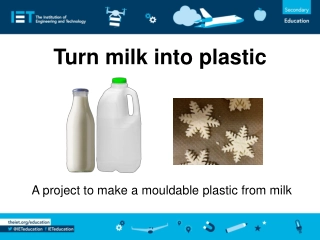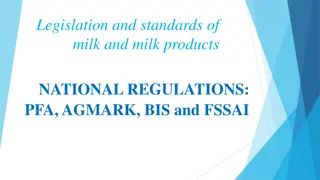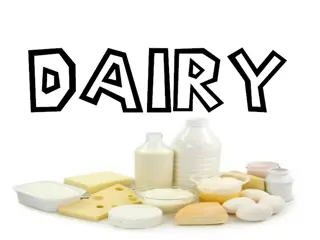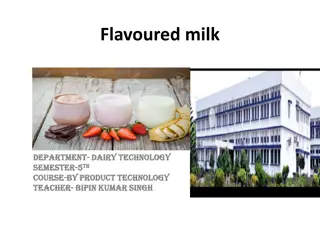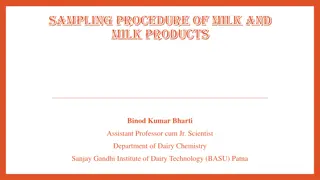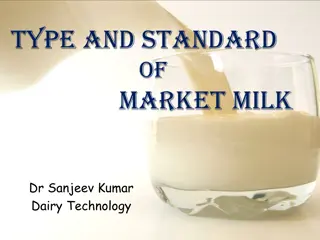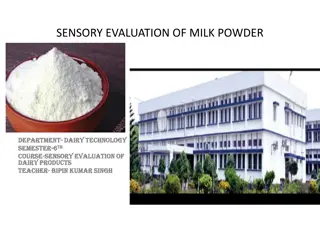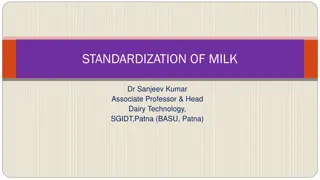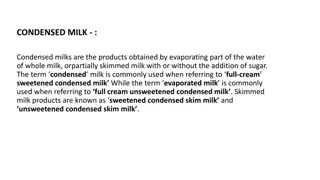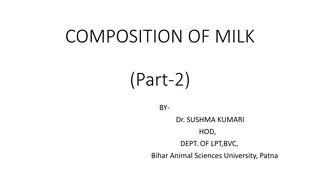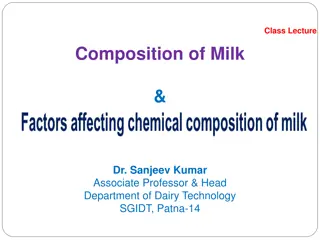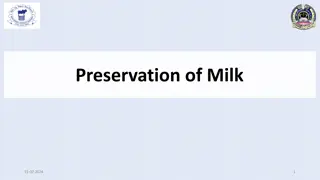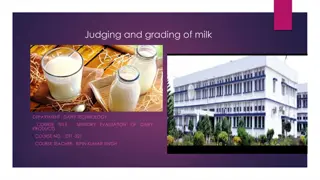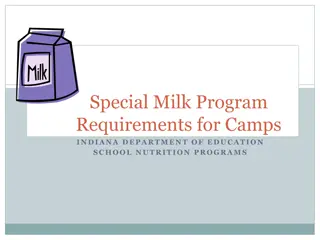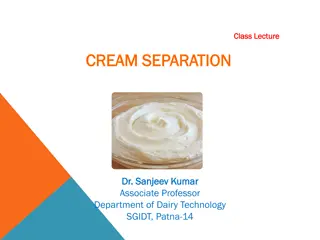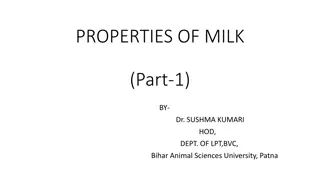
Milk Production Process: From Digestion to Composition
Discover how milk is made, starting with digested food carried into the udder through the blood vessels. Learn about the milk secreting cells, milk ducts, and milk chambers involved in the process. Explore the composition of milk, including water, fat, protein, lactose, and minerals. Calculate the amount of milk used in your home daily, weekly, monthly, and yearly. Uncover fascinating insights into the dairy industry and the essential role cows play in providing this nutritious beverage.
Download Presentation

Please find below an Image/Link to download the presentation.
The content on the website is provided AS IS for your information and personal use only. It may not be sold, licensed, or shared on other websites without obtaining consent from the author. If you encounter any issues during the download, it is possible that the publisher has removed the file from their server.
You are allowed to download the files provided on this website for personal or commercial use, subject to the condition that they are used lawfully. All files are the property of their respective owners.
The content on the website is provided AS IS for your information and personal use only. It may not be sold, licensed, or shared on other websites without obtaining consent from the author.
E N D
Presentation Transcript
How milk is made Digested food is carried by the blood into the udder. 1. Here the blood vessels branch off into tiny capillaries. The food leaves the blood and enters the cells in the upper part of the udder. These are called the milk secreting cells or alveoli. (The blood continues through more capillaries and leaves by two milk veins.) 2. The milk passes down through the milk ducts, from the milk secreting cells in the upper udder, into four milk chambers or cisterns, found in the four quarters of the udder. 3. As milk is squeezed out through the teat canals more milk drains down into the cisterns from the upper udder. 4. Forty litres of blood are needed to carry enough food to the udder to make one litre of milk. 5.
Exercise Ruby, a Kiwicross cow, produces 17 litres of milk a day. How many litres of milk do you use on average in your home each day, each week, each month and each year? 1. How long would a day s supply of Ruby s milk keep your family going? 2. How many litres of milk does your home use a year? If this milk was needed all at once, how many cows would be needed? 3.
Summary of how milk is made. four, blood, milk, food, alveoli, quarters, one, upper teat, 1. Digested food is carried by the _____________into the udder. 2. Here the blood vessels branch off into tiny capillaries. The__________ leaves the blood and enters the cells in the ________ part of the udder. These are called the ________ secreting cells or___________. The blood continues through more capillaries and leaves by two milk veins. 3. The milk passes down through the milk ducts from the milk secreting cells in the upper udder, into __________milk chambers found in the four ____________ of the udder. 4. As milk is squeezed out though the ________ canal more milk drains in to the chambers from the upper udder. 5. 40 litres of blood is needed to carry enough food to the udder to make ______ litre of milk.
Use the words to complete the paragragh. four, tubes, blood, milk udder, let down, quarters, teat, milk, glands There are ____________parts or _______________ to an udder. Each quarter consists of thousands of tubes where ____________ is made. Each milk gland has a good ___________ supply. Material to make milk are ___________ to the glands by the blood. Squeezing the milk out of the milk glands is called ________________. Then the milk travels down the milk ______ into the lower part of the _______ and out of the _________.
Composition Composition Milk Colostrum % % Water Fat Protein Lactose Salt and minerals 86.7 4.5 3.7 4.7 0.4 Water Fat Protein Lactose Salt and minerals 76.8 5.4 14.6 2 1,2
Making Milk Read the worksheet making milk and answer the questions. Where in the udder is milk stored? 1. Name the hormone that is released to let milk down 2. Explain what happens when a calf or a lamb suckles. 3. Explain how the hormone oxytocin works. 4. Explain what stimulates dairy cows to let milk down 5. Explain what adrenalinis and the effect it has on milk let down 6.
Milking intervals The traditional milking interval is twice a day. However Some farmers milk once a day for whole or part of the season. have a flexible milking interval for whole of part of the season. Flexible milking is a term for milking practices that fall between the traditional once-a-day (OAD) or twice-a-day (TAD) milking Examples are milking three times in two days (3-in-2) ten milkings in seven days (10- in-7)
Reason farmers milk once a-day of flexible milking Reasons farmers consider once-a-day milking (OAD) The advantages depends on it the farm system or layout and can include: Less time spent milking cows To reduce staff pressure Feed shortage (plan to milk OAD before feed runs short rather than be forced into it) Stock health (lame cows, light cows, heifers, milk- fever prone cows) Reproduction (non-cyclers, heifers or whole herd in a feed shortage) Small dairy shed for herd size Farm layout (walking distance to shed) Reasons for a flexible milking system The benefits of flexible milking are improved staff wellbeing and cow health, but, there are some challenges, such as grazing and pasture management.
Milking Read the Milking worksheet Questions 1. Describe how to hand milk a cow. 2. Describe how milk is harvested from a cow by a milking machine.

